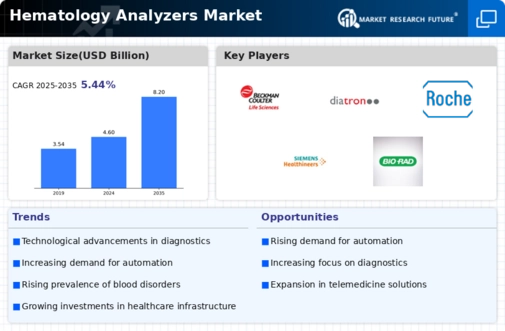Market Growth Projections
The Global Hematology Analyzers Market Industry is projected to experience substantial growth over the next decade. With an estimated market value of 4.6 USD Billion in 2024, it is expected to reach 8.2 USD Billion by 2035. This growth trajectory indicates a compound annual growth rate of 5.4% from 2025 to 2035. Such projections reflect the increasing adoption of hematology analyzers in clinical laboratories and point-of-care settings, driven by technological advancements and rising healthcare demands.
Rising Prevalence of Blood Disorders
The Global Hematology Analyzers Market Industry experiences growth driven by the increasing prevalence of blood disorders, such as anemia, leukemia, and hemophilia. As healthcare systems worldwide prioritize early diagnosis and effective management of these conditions, the demand for advanced hematology analyzers rises. For instance, the World Health Organization reports that anemia affects approximately 1.62 billion people globally. This growing patient population necessitates the adoption of sophisticated diagnostic tools, contributing to the market's projected value of 4.6 USD Billion in 2024 and an anticipated increase to 8.2 USD Billion by 2035.
Rising Awareness of Preventive Healthcare
The Global Hematology Analyzers Market Industry is also propelled by the rising awareness of preventive healthcare among populations. As individuals become more health-conscious, there is a growing emphasis on regular health check-ups and screenings. This trend encourages healthcare providers to invest in advanced diagnostic tools, including hematology analyzers, to facilitate early detection of potential health issues. Educational campaigns and initiatives promoting preventive healthcare are likely to contribute to increased testing rates, thereby driving the demand for hematology analyzers in various healthcare settings.
Increasing Demand for Point-of-Care Testing
The Global Hematology Analyzers Market Industry is significantly influenced by the rising demand for point-of-care testing (POCT). This trend is driven by the need for rapid and accurate diagnostic results in various healthcare settings, including emergency departments and outpatient clinics. POCT hematology analyzers provide immediate results, facilitating timely clinical decisions. The convenience and efficiency of these devices are particularly appealing in regions with limited access to traditional laboratory facilities. Consequently, the market for hematology analyzers is expanding, as healthcare providers increasingly adopt POCT solutions to enhance patient care.
Growing Investment in Healthcare Infrastructure
Investment in healthcare infrastructure is a critical driver of the Global Hematology Analyzers Market Industry. Governments and private entities are increasingly allocating resources to improve healthcare facilities, particularly in developing regions. This investment leads to the establishment of modern laboratories equipped with advanced hematology analyzers, thereby enhancing diagnostic capabilities. For instance, initiatives aimed at strengthening healthcare systems in Africa and Asia are likely to boost the demand for hematology analyzers. As a result, the market is poised for growth, aligning with the overall expansion of healthcare services globally.
Technological Advancements in Diagnostic Equipment
Technological advancements play a pivotal role in shaping the Global Hematology Analyzers Market Industry. Innovations such as automated analyzers, improved software algorithms, and integration with laboratory information systems enhance the accuracy and efficiency of blood analysis. For example, the introduction of multi-parameter analyzers allows for comprehensive testing in a single run, reducing turnaround times. These advancements not only improve patient outcomes but also streamline laboratory workflows, thereby driving market growth. As a result, the market is expected to witness a compound annual growth rate of 5.4% from 2025 to 2035.






